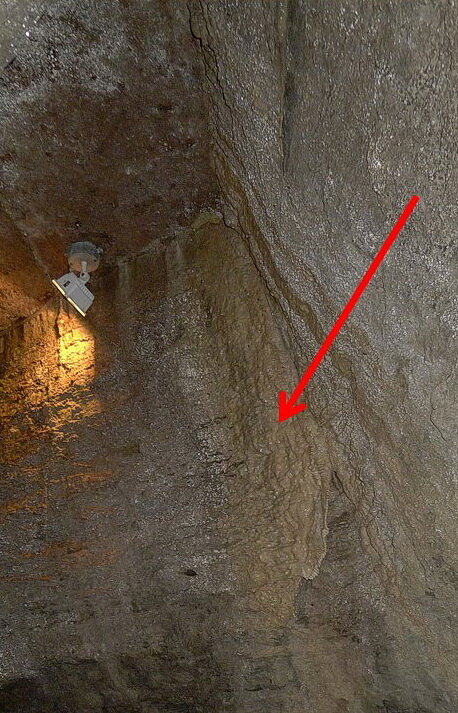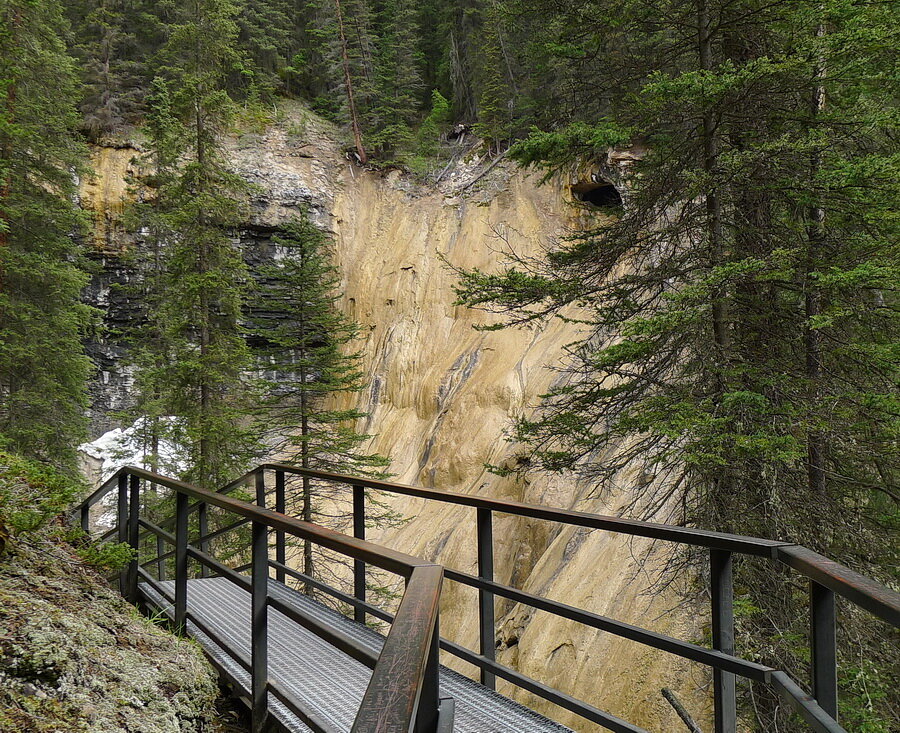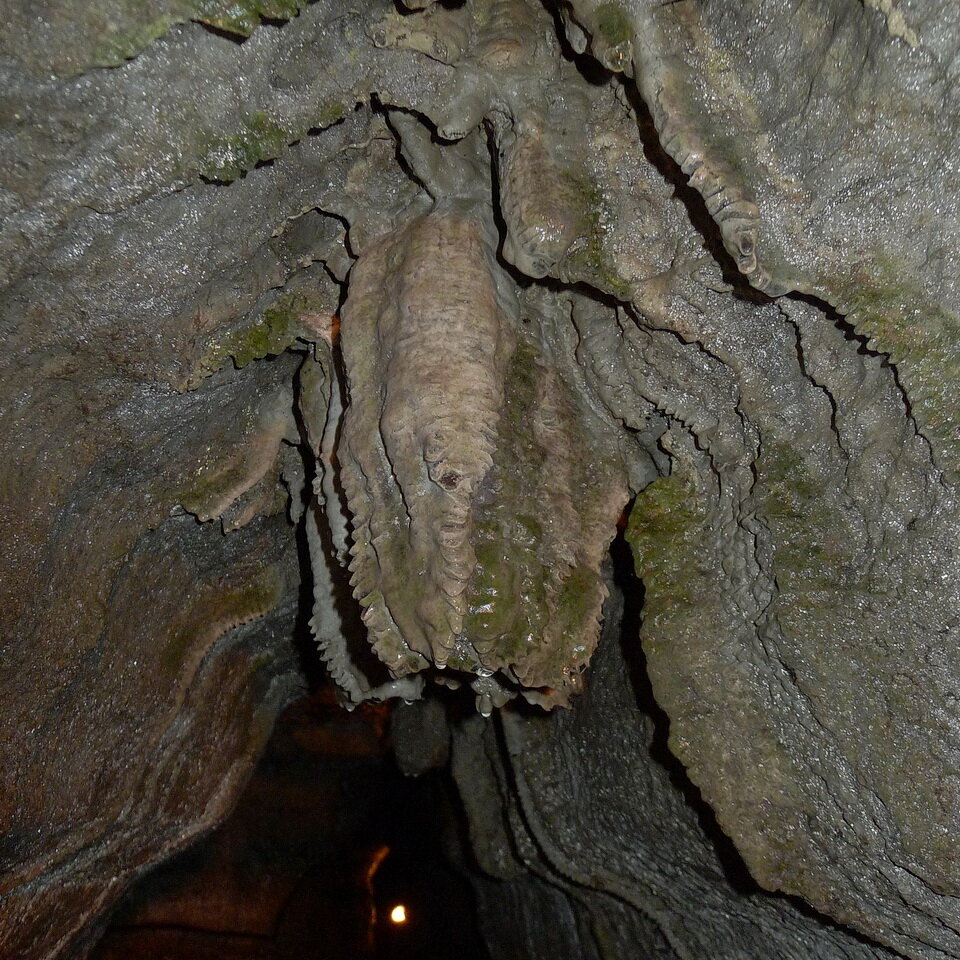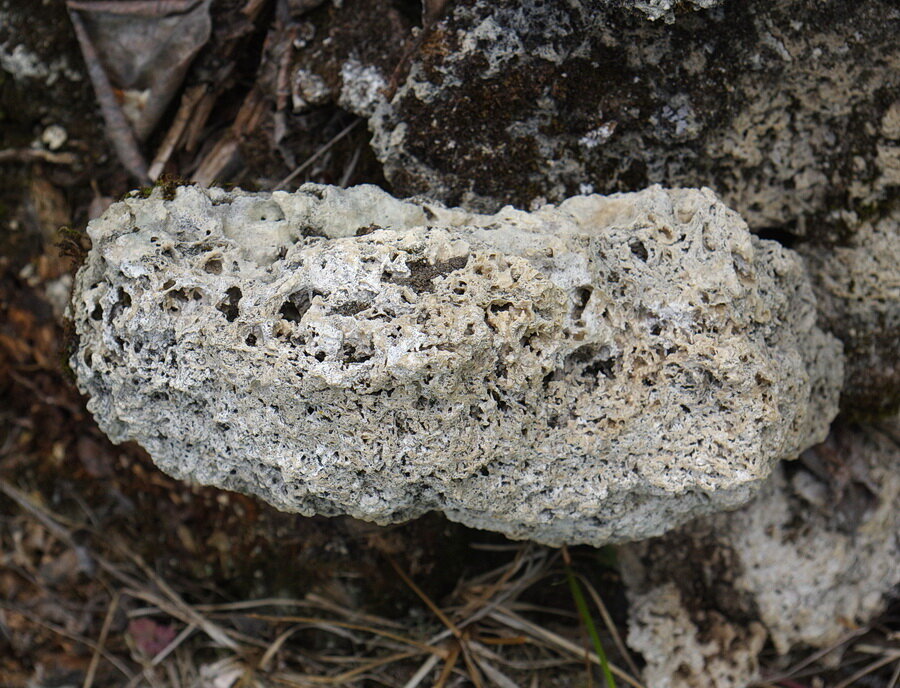Flowstone, Travertine And Tufa
In this note I describe some field and geochemical characteristics of flowstone, travertine and tufa. I describe the processes that formed them. Some people use the term flowstone to include travertine and tufa. I separate them in this note because of the differences in the way they may form.
Part 1: Physical features of Flowstone, Tufa and Travertine
Flowstone, travertine and tufa are different types of calcareous, or lime-rich, terrestrial, deposits that are similar in composition to limestone bedrock (CaCO3). However, there is a big difference between limestone bedrock and flowstone, travertine and tufa deposits. Flowstone, travertine and tufa are formed by precipitation of calcium carbonate (CaCO3) from mineralized groundwater, in terrestrial settings, often in proximity to pre-existing limestone or dolomite bedrock. Conversely, limestone bedrock was created by the accumulation and lithification of calcium carbonate muds and shells of dead marine animals on the floor of a tropical, or subtropical, ocean.
Understanding flowstone, travertine and tufa deposits helps us understand past climates, types of groundwater in an area, the nature of rock-water reaction, the distribution of some plants, and may even help us mitigate climate change.
Flowstone
Flowstone is a type of calcium carbonate (CaCO3) deposit that precipitated from cool, mineralized groundwater. Flowstone forms when calcium carbonate minerals precipitate, or “fall out” of, or crystallize from, cool, mineralized groundwater that flowed along an existing surface, including cliff walls, cave walls, cave roofs, and cave floors.
Flowstone:
consists of thin sheets, or layers, of calcium carbonate (CaCO3);
is composed of the mineral calcite (CaCO3) and other carbonate minerals;
initially forms layers that conform to the shape of the surface they form on, but over time, the form becomes more rounded, or dome-shaped, as the deposit gets thicker;
generally has a buff colour, although inclusion of iron impurities gives flowstone a brown colour; and
is generally developed in, and on, limestone bedrock cave, although any rock surface may get covered by flowstone if the local groundwater contains dissolved calcium (Ca) and carbon dioxide gas (CO2).
Cave flowstone exists as:
a layered sheet that covers the wall or floor (Photo 1);
a thin flowstone sheet that descends from overhanging parts of a wall, called a drape, drapery, or curtain (Photo 2); and
a feature called speleothem. Speleothems that hang from a cave roof, like icicles, are called stalactites. Speleothems that grow vertically on a cave floor are called stalagmites (Photo 3).
Photo 1: Flowstone, made from calcium carbonate (CaCO3), covers a vertical wall in a limestone cave. The red arrow points the flowstone. Image by Andy Fyon, composed in the Bonnechere Cave, Eganville, Ontario, July 27, 2016.
Photo 2: Buff-coloured flowstone drape, made of calcium carbonate (CaCO3), covers a vertical wall along the Johnston Canyon, Banff National Park, Alberta. Johnston Canyon formed when the ancestral Johnston Creek eroded down through the limestone bedrock. Image by Andy Fyon, June 26, 2014.
Photo 3: A stalactite is a type of speleothem that forms in a limestone cave, that is made from calcium carbonate (CaCO3), and that hangs from the cave roof like an icicle. The stalactite occurs in the centre of this photo. Image by Andy Fyon, composed in the Bonnechere Cave, Eganville, Ontario, July 27, 2016.
Flowstones can form outside the cave environment, on cement, for example, and those flowstones are classified as calthemites. They form by degradation of concrete. Flowstones can also form on the walls of canyon, under the right conditions.
Tufa
Tufa is another type of calcium carbonate (CaCO3) deposit. Tufa:
forms when small grains of calcium carbonate, often in the form of the mineral calcite (CaCO3), precipitate from cold to warm mineral spring water, not hot spring water;
is generally not very well bedded;
is generally very porous, meaning it is full of tiny holes or spaces between the calcium carbonate grains (Photo 4); and
can contain remains of plants that were growing in the area where the tufa formed.
The porosity cavities are partly the result of the decay of mosses and other plant material that were trapped in the tufa and that may have helped precipitate the mineral calcite.
Tufa can form in a variety of habitats, including: a) creek or river channels; b) lacustrine, lake environments; and c) land surfaces where subterranean groundwater discharges onto, and flows over, the land surface. Calcareous wetlands are often associated with the surface groundwater discharges that create tufa. Tufa towers can form in lakes when calcium-rich underwater springs mixes with lake water that is rich in carbonates (aka. baking soda). Mono Lake Tufa State Natural Reserve, in California, is one example of tufa towers that formed beneath the surface of the lake water.
Photo 4: Tufa is a porous calcium carbonate (CaCO3) deposit formed by precipitation from cool mineralized groundwater springs. The pores show as spaces within the deposit. Photo by Andy Fyon, Warm Bay, Atlin Lake, British Columbia, July 16/19.
Tufa forms by both abiotic, meaning no plant or biological activity was involved, and biotic precipitation, meaning some plant or biological activity was involved. I provide more insight about abiotic and biotic precipitation of calcite below.
Travertine
Travertine is a third type of calcium carbonate (CaCO3) deposit. Travertine (Pentecost, 2005):
is composed of the calcium carbonate mineral named calcite or aragonite;
is characteristically finely laminated, or bedded;
is made of layers, or beds, that are usually wavy in cross section and inclined along the slope;
rarely has horizontal bedding;
has generally has low porosity, meaning there is not a lot of pore space between the calcite mineral crystals. The calcite grains grew in a way that eliminated most of the space between the mineral grains. This contrasts with tufa, which generally has abundant pore space.
Travertine formed by precipitation of calcite from warm to hot mineralized water, on the land surface, around groundwater seeps, mineral springs, along streams and rivers, and sometimes in lakes. Close to the hot water discharge site, travertine forms calcite or aragonite mineral crusts. In the parts of the hot water system that are more distant from the discharge source, laminated travertine is more common (Pentecost, 2005). Some laminated travertine is considered to have formed from processes that involved bacteria or algae. Those are called biotic processes. Laminations occur on a millimeter- to centimeter-scale and are interpreted as daily to seasonal growth rhythms (Anna Gandin & Enrico Capezzuoli 2008).
Part 2: Formation of These Deposits
Flowstone, tufa and travertine enjoy some differences in the way they form, but they share some common factors - an important one being the presence of mineralized water. In Part 2, I examine some of the key factors that lead to the formation of these calcareous deposits.
Water Source
For these calcium carbonate deposits, meteoric groundwater, derived from rain, melting snow, and other surface waters is the source of mineralized water.
Groundwater Circulation Plumbing System
A plumbing system is needed to channel surface waters into subsurface, where that water becomes groundwater. That groundwater uses the plumbing system to circulate beneath the Earth’s surface. Faults, fracture systems, karst crevices, and karst caves serve as the plumbing system, although any rock opening can serve as a plumbing system so long as the plumbing system is connected to the surface.
Low temperature, shallowly circulating, calcium-rich groundwater systems are generally responsible for the flowstone and tufa formation. Higher temperature, deeply circulating groundwater systems are generally responsible for the travertine formation.
Calcium Source
When groundwater circulates through bedrock, the groundwater reacts with the bedrock and dissolves components from the rock. Where the bedrock is a calcium-rich rock, such as limestone, dolostone, or gypsum, the groundwater dissolves, and becomes mineralized with, the element calcium. In areas dominated by limestone, dolostone, and gypsum bedrock, the rock-groundwater dissolution reaction creates voids in the bedrock. Those voids are called karst features. The enhanced permeability helps create the subsurface plumbing required for the groundwater to circulate.
For the hot, deeply circulating geothermal systems, minerals dissolved by the hot groundwater may be derived from many types of bedrock, including limestone, dolostone, gypsum, as well as pre-existing igneous, metamorphic, or other types of sedimentary rock. The bedrock mineral source may not be exposed on surface.
Heat Source
To evolve into a hot water geothermal system, capable of creating travertine, an heat source is required to create hot groundwater. Cooling igneous rock is one possible heat source. In addition, the Earth naturally becomes hotter with depth at a rate of 25–30 °C/km (72–87 °F/mi) of depth near the Earth’s surface. That natural, geothermal gradient is capable of creating hot groundwater.
Abiotic Formation Of Flowstone, Tufa, and Travertine Deposits
In this section we will look at some chemical reactions and equations that describe the precipitation of the calcium carbonate mineral.
Most flowstone, travertine, and tufa deposits commonly formed from abiotic processes, meaning the calcium carbonate mineral formed by abiotic chemical precipitation without the influence of bacteria, algae or plant respiration.
The text notations used in the equations are listed here:
The formation of abiotic calcium carbonate involves chemical reactions in groundwater that contains: a) calcium ions; b) bicarbonate ions; c) carbonate ions; and d) dissolved carbon dioxide (CO2) gas. Calcium carbonate precipitation takes place near, and on, the Earth’s surface.
Geologists call this the terrestrial environment (Pentecost, 2005). Key in these processes is degassing, or loss, of carbon dioxide gas, which is dissolved in the mineralized groundwater (Photo 5). The degassing takes place at, or near, the Earth’s surface.
Photo 5: A common way to precipitate the mineral calcite (CaCO3) from water is to degas carbon dioxide (CO2) that is dissolved in the water. The red arrow illustrates the “direction” the chemical reaction will follow when CO2 is degassed. Degassing will cause calcite (CaCO3) to “fall out” or precipitate from the water solution.
Carbon dioxide degassing may occur as the result of:
agitation of the water, where the water flows over waterfalls, rapids and obstructions, like rocks along the flow bed;
evaporation of the water;
loss of carbon dioxide from the groundwater because the water contains more dissolved carbon dioxide than occurs in the ambient atmosphere or air.
In these cases, carbon dioxide gas dissolved in the groundwater escapes from the water into the ambient atmosphere, or air, as soon as the groundwater approaches and reaches the land surface. That causes calcite to precipitate from, or “fall out” or, the groundwater solution (Photo 5). As a result of degassing, layer upon layer of calcite precipitates from the groundwater.
Degassing and abiotic precipitation of calcite is illustrated by chemical reactions [1], [2] and [3], below. The symbol “=” represents equilibrium, or steady state:
Water + Carbon dioxide = Carbonic acid [1]
Calcite + Carbonic acid = Calcium ion + 2Bicarbonate ions [2]
We can simplify the reactions by combining reactions [1] and [2] into reaction [3]:
Calcite + Carbon dioxide + Water = Calcium ion + 2Bicarbonate ions [3]
When carbon dioxide gas degasses and leaves the groundwater, reaction [3] is pulled to the left, meaning that the dissolved calcium ions combine with the dissolved bicarbonate in the groundwater to create more water and more carbon dioxide gas to compensate for the degassed carbon dioxide. Calcite precipitates.
Abiotic Precipitation of Calcium Carbonate by Evaporation:
Carbon dioxide gas is also lost from the mineral groundwater by evaporation when cool groundwater flows over a warm land surface. Evaporation may be take place in response to the increase of water temperature at the interface between the air and water in a shallow basin or when thin film of groundwater flows over a warm surface, such as a sun-heated rock.
Abiotic Precipitation of Calcium Carbonate by Addition of Carbon Dioxide
In some unusual cases, travertine is precipitated when carbon dioxide gas moves from the atmosphere into the mineral groundwater, as shown in reaction [4]:
Calcium hydroxide + Carbon dioxide = Calcite + Water [4]
This environment of travertine formation is not common, but does occur where ultramafic rocks, like peridotite, undergo carbonation reaction. In this case, carbon dioxide gas from the atmosphere reacts with the rock to form calcite or magnesite, the magnesium-carbonate mineral.
Interestingly, the addition of carbon dioxide gas from the atmosphere to the groundwater, followed by chemical reaction with a peridotite bedrock, is a natural form of sequestration of atmospheric carbon dioxide. That sequestered carbon dioxide becomes stored in, and on the land surface, as travertine, tufa, or minerals like magnesite.
Biogenic Precipitation of Calcium Carbonate
Under calm or static water conditions, biological activity, such as photosynthesis by plants, removes carbon dioxide gas (CO2) that is dissolved in the water. Removal of CO2 gas by photosynthesis cause the chemical reaction to follow the red arrow direction in Photo 5. That causes the precipitation of travertine and tufa. In addition, bacterial colonies, established in the more tranquil parts of a surface flow, may incorporate calcium carbonate particles in a calcareous bio-film.
Acid vs Alkaline Groundwater
This is a complex topic beyond the scope of my note. I share only a couple of examples to remind us that rock-water-CO2 reactions are much more complicated that I have inferred.
The pH, also known as the acidity, of mineral-rich groundwater that produces travertine and tufa deposits is generally alkaline (pH > 7), especially where circulating groundwater reacts with pre-existing dolostone, limestone, or gypsum bedrock. Unusually alkaline, mineral-rich groundwater that produces travertine and tufa deposits can have a pH of 11 to 12 where the circulating groundwater reacted with rocks like peridotite bedrock.
Rarely, acidic, low pH, mineral-rich groundwater can produce travertine and tufa deposits, such as at Yellowstone, in the western USA.
Flowstone, Travertine and Tufa Uses
Past climates: Flowstone requires water to form. Therefore, the absence of flowstone may indicate a past dry period. This insight can help us understand if, and when, past climates were dry or wet. Insights about past climate are also gained from the carbon and oxygen stable isotopes of the calcium carbonate that make up travertine deposits found in caves.
Ornaments: Flowstone is used to make ornaments, like bowls, and a special type of ornamental building stone.
Counter tops and tiles: Travertine tends to hold together. Therefore, it is used to make tiles and counter tops. Tufa is commonly used to make specialized flower pots, especially for plants that require calcium-rich soil conditions.
Archaeological insights: The age of some archaeological artifacts can be determined by using the products of a complicated radioactive decay series called the uranium series dating of the travertine. The age of an artifact is important to help understand when ancient humans were active in a geographic area.
Groundwater: Studying fluids trapped as small bubbles in the tufa and travertine deposits provide insights about the groundwater in an area. Where travertine formed in an area of recent volcanic activity, we gain insights into the ways groundwater reacted with the hot, igneous rocks in the area.
Extremophile life: Studying travertine formed from unusual and very acidic mineral waters, such as at Yellowstone, helps us understand the conditions under which some life forms tolerate extreme temperature and pH conditions. Those life forms are called “extremophiles”. Understanding extremophiles may help us understand early life on Earth and possible on other planets.
Summary
Travertine, tufa and flowstone are composed of calcium carbonate, generally the mineral calcite. These deposits form on the land surface, in caves, and even in lakes. Travertine tends to form from warm to hot groundwaters. Tufa and flowstone tend to form from groundwaters. Exceptions exist!
The calcium carbonate may precipitate because CO2 gas dissolved in the groundwater degasses, and leaves the groundwater in response to evaporation of the water, warming of the water, and turbulent water flow.
By studying these calcium carbonate deposits, we gain insight about past climates, ages of human activities, and groundwater quality.
We use these deposits for table tops, ornaments, and garden planters.
Nov. 24, 2020; Nov 22/21; March 15/22.





